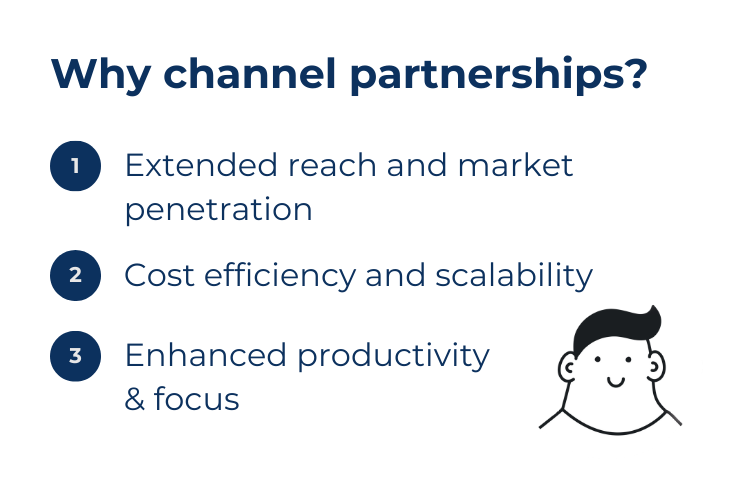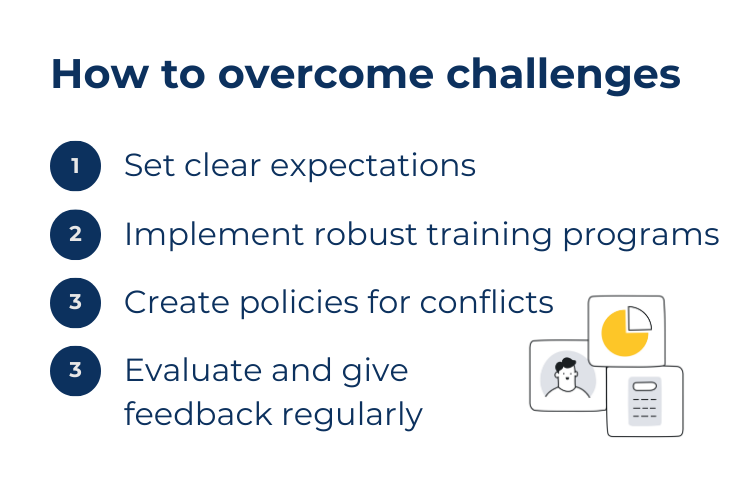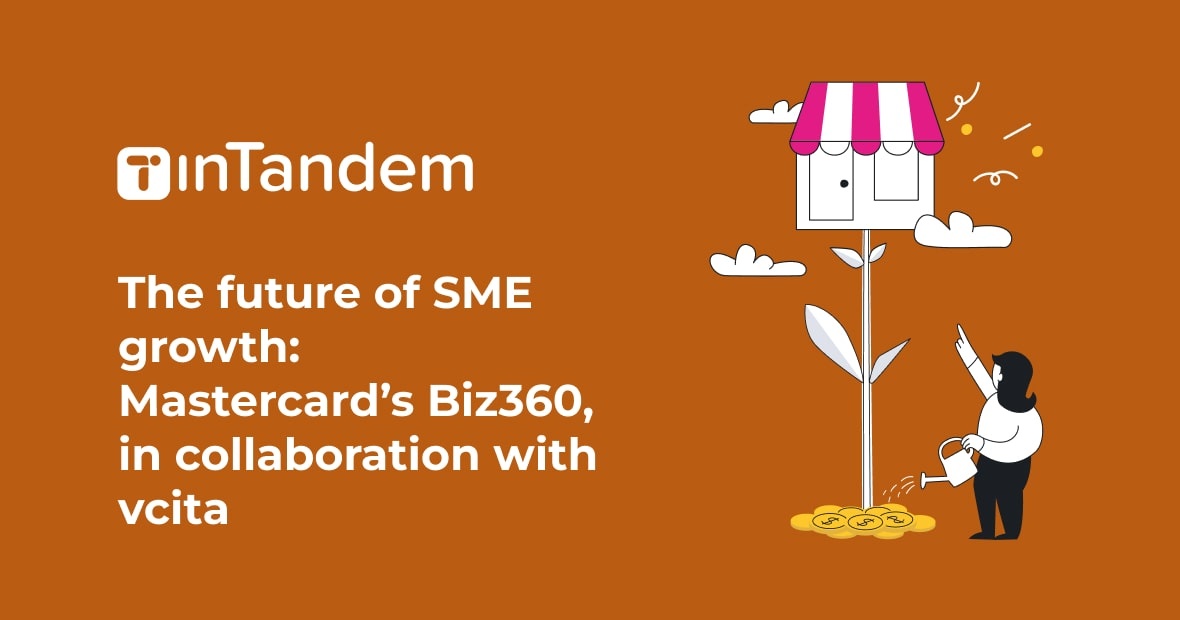Channel partnerships can be a game-changer for organizations that are looking for ways to expand their reach, bring their products and services to more small business customers, and maximize their potential for growth. The right channel partner enables you to pool resources and leverage each other’s strengths.
With an effective channel partnership program, you can enter new markets, build relationships with new customer segments, and enhance your reputation and revenue without a great deal of effort. In this article, we’ll discuss different types of channel partnership programs, the benefits they can bring, and how to effectively establish and manage a successful channel partnership.
Understanding channel partnerships
Before you begin working on a channel partnership strategy and searching for appropriate channel partners, it’s important to understand what makes channel partnerships effective for organizations serving small businesses.
What are channel partnerships?
Channel partnerships are a type of business collaboration which focuses on distribution and sales channels. In a channel partnership, one partner is the manufacturer or provider which provides products or services, and the other partner is the channel partner which helps sell and distribute them.
Channel partnerships are different to strategic partnerships, because they focus only on sales and distribution. Strategic partnerships are deeper collaborations that can also involve other aspects of business operations. With channel partnerships, the goal is to extend the provider’s reach and grow their customer base, but strategic partnerships can cover more complex goals.
Types of channel partnerships
There is a number of different types of channel partnership, but the most common are reseller partnerships, distribution partnerships, and referral partnerships. The one you choose will depend on your specific goals, products, and market dynamics.
Reseller partnerships
Reseller partnerships are where the channel partner resells the manufacturer’s products or services to their own audience. Usually, the reseller buys those products/services at a discount and then resells them for a higher price to keep the profit margin.
It’s a good choice for organizations that already have an established product or service but want to reach a broader market, especially in industries where different retailers or resellers can reach different customer segments. For example, a software company might use a reseller partnership to expand its distribution through more retailers.
Distribution partnership
In a distribution partnership, a manufacturer or supplier collaborates with a distribution partner to get its products to end users. The distribution partner takes care of issues like logistics, warehousing, and transportation, to ensure they reach the customers or retailers efficiently.
Distribution partnerships are appropriate for companies that produce goods on a large scale and need infrastructure, delivery expertise, or both to help them supply customers successfully. For example, a toy company might use a distribution partner to deliver its products to toy stores and/or direct customers.
Referral partnership
With referral partnerships, one company recommends the other company’s products or services to its own audience. It’s similar to a reseller partnership, but the referral partner receives a commission or another kind of compensation, instead of keeping the profits from resale.
Referral partnerships are suitable for businesses that want to expand their customer base through word-of-mouth marketing, especially those in industries that rely heavily on trust and personal recommendations. For example, an insurance company might work with a referral partner to tap into new customer segments through recommendations from trusted partners.
The importance of channel partnerships

By partnering with other businesses, you’re able to improve your sales and marketing with relatively little effort. Here are some of the main benefits that you can expect to see from a channel partnership program.
Extended reach and market penetration
Business growth requires constantly looking for new customers and markets. You can build these new relationships alone, but working with channel partners who are already established in the geographic areas, customer segments, or sales channels that you want to target smoothes the path considerably.
A channel partnership allows you to leverage your partner’s existing distribution networks, customer bases, and expertise. By combining resources and capabilities, you’ll also boost your collective marketing and distribution strength, ultimately tapping into a broader market and increasing overall market penetration. Two partners working together can expand into areas that might be beyond the reach of a single company.
Cost-efficiency and scalability
When you collaborate with a channel partner, you’ll be able to share resources, leverage each other’s strengths, and streamline operations to reduce redundant costs and optimize efficiency. Together you can negotiate better deals with suppliers, benefit from shared marketing expenses, and utilize existing distribution channels more effectively to achieve economies of scale.
Channel partnerships are also scalable. As your business grows, you can adapt your channel partnership strategy to handle increased demand and reach, providing a more flexible and efficient way to expand operations without incurring proportionally higher costs.
Enhanced productivity and focus
Partnering with another business means that each of you can focus on your core competencies and strengths. Companies can delegate specific responsibilities to the channel partner that’s best equipped to handle them, reducing the burden on individual teams and improving overall productivity.
By leveraging your partner’s expertise, you can concentrate on your strategic objectives, enhance innovation, and improve key business functions without spreading resources thinly across a multitude of tasks. This targeted approach enables a more strategic and streamlined allocation of resources, fostering a more effective and competitive business environment.
How to nurture successful channel partnerships
It’s important to note that all these advantages only come when you work with a suitable partner for your situation and succeed in building channel partnerships that are well-aligned and robust. Here are three tips for nurturing effective channel partnerships.
Ensure clear communication and alignment
One of the most critical elements to a successful channel partnership is to find a business that aligns well with your needs and value proposition. Look for a company that:
- Brings strengths and capabilities that complement your own, like a different skill, market expertise, or technology
- Has a target market that you want to enter
- Shares compatible business goals and objectives so that you can work towards a common milestone
- Shares your values and culture, so you can build a more cohesive working relationship
- Has a positive reputation that will bolster your brand image and build more trust with customers
- Is flexible and able to adapt to changes in the market or business landscape, so it can evolve with your business
- Complies with all the relevant legal and regulatory requirements for your industry
It’s also critical to find a company that prioritizes communication and transparency in business dealings. Effective communication is essential for addressing challenges, aligning strategies, and ensuring a smooth partnership.
Run training and support programs
Once you find a suitable channel partner, you’ll need to make sure that they have everything they need to work with you and help you meet your goals. Training and support programs empower your business with the knowledge, skills, and resources they need to effectively represent and sell your products or services.
A good training program should:
- Provide comprehensive training on product features, benefits, and positioning
- Ensure that partners have a deep understanding of what they are offering
- Offer guidance on sales techniques, marketing strategies, and customer support
- Enable partners to address customer inquiries and concerns with confidence
You’ll also need to share regular updates and ongoing support to keep your partners informed about changes in products or services, market trends, and industry developments. Ultimately, well-executed training and support programs enhance the partner’s ability to deliver value to customers, drive sales, and contribute to the overall success of the channel partnership.
Establish performance metrics and incentives
Moving forward, you’ll need to incorporate performance metrics and incentives so as to establish a framework for measuring and rewarding the achievements of both parties. The metrics you monitor could include:
- Sales targets
- Market share growth
- Customer satisfaction levels
Metrics offer an objective way to measure whether the partnership is meeting your needs, while incentives motivate your channel partners to meet or exceed these performance metrics. You can offer incentive programs like bonuses, commissions, or rewards.
It’s important to regularly assess performance through metrics, so you can make strategic adjustments and ensure that the partnership remains dynamic and responsive to changing market conditions.
Channel partnerships in real-life
Channel partnerships aren’t just a theoretical concept. Many organizations, including some well-known brands, use them to continue driving growth and income. For example, Accenture partnered with Google Cloud to offer an AI Center of Excellence (CoE). Business customers can use it to access Google’s generative AI portfolio and Accenture’s data and AI architects. This extends the reach of both partners while also boosting their reputations for assisting businesses.
Another example is the partnership between CDW and BitDefender. CDW offers BitDefender’s cybersecurity solution to its business customers to help them improve their endpoint security. BitDefender benefits from the increased sales and raised customer trust as a result of CDW’s reputation, and CDW can serve customers more effectively with BitDefender’s solution.
How to overcome challenges with channel partnerships

Like all relationships, channel partnerships don’t always run smoothly. Here are some of the common challenges that face channel partnerships, and tips for how to overcome them.
Avoid misunderstandings by setting expectations
When goals and expectations are poorly aligned, it can lead to misunderstandings and conflicts. The best way to resolve this is to do your utmost to establish open lines of communication from the very beginning.
It’s important to define the roles, responsibilities, and deliverables for both the provider organization and the channel partners, and to revisit and revise them regularly as the partnership evolves.
Ensure deep product knowledge with robust training programs
When your channel partners don’t have sufficient knowledge and understanding about your products, services, or value offering, it handicaps their ability to drive sales and represent your brand.
Overcome this obstacle by implementing comprehensive and engaging training programs that equip your channel partners with the necessary information and skills to effectively showcase your organization. Couple this with continual support through knowledge base resources, documentation, and dedicated teams that can address queries and challenges.
Resolve conflicts with clear policies
Sometimes, channel partners can end up disputing issues like lead ownership or territorial primacy. These disagreements can grow and risk threatening the entire partnership, but proactive conflict management can prevent them from escalating and damaging the relationship.
It’s best to prevent serious conflicts from arising by outlining clear procedures for conflict resolution. Define paths of escalation and put in place mechanisms to mediate disputes swiftly and impartially from the beginning of the partnership.
Prevent disappointments with regular evaluation and feedback
Some companies feel uncomfortable about setting up performance tracking and monitoring within their channel partnership, but without such a framework there’s a risk that channel partners don’t meet your expectations and bitter disappointment ruins what could have been a fruitful collaboration.
It’s far better to set up a regular performance evaluation system, including key performance indicators (KPIs) that are aligned with the partnership’s goals. Include pathways for you to deliver constructive feedback and recognize achievements, and agree on evaluation periods. This ensures that both parties stay focused on shared objectives, and make necessary adjustments to enhance collaboration.
A fruitful channel partnership can boost your business growth
Overall, a channel partnership program brings immense potential to increase revenue and build brand trust. Setting up a well-defined framework in which both partners are clear about their responsibilities and expectations, including concrete goals and performance metrics, is the foundation of a successful channel partnership that benefits both parties. With the right channel partners, large organizations can expand their profits while assisting more small businesses to access the tools and products they need to grow.



























